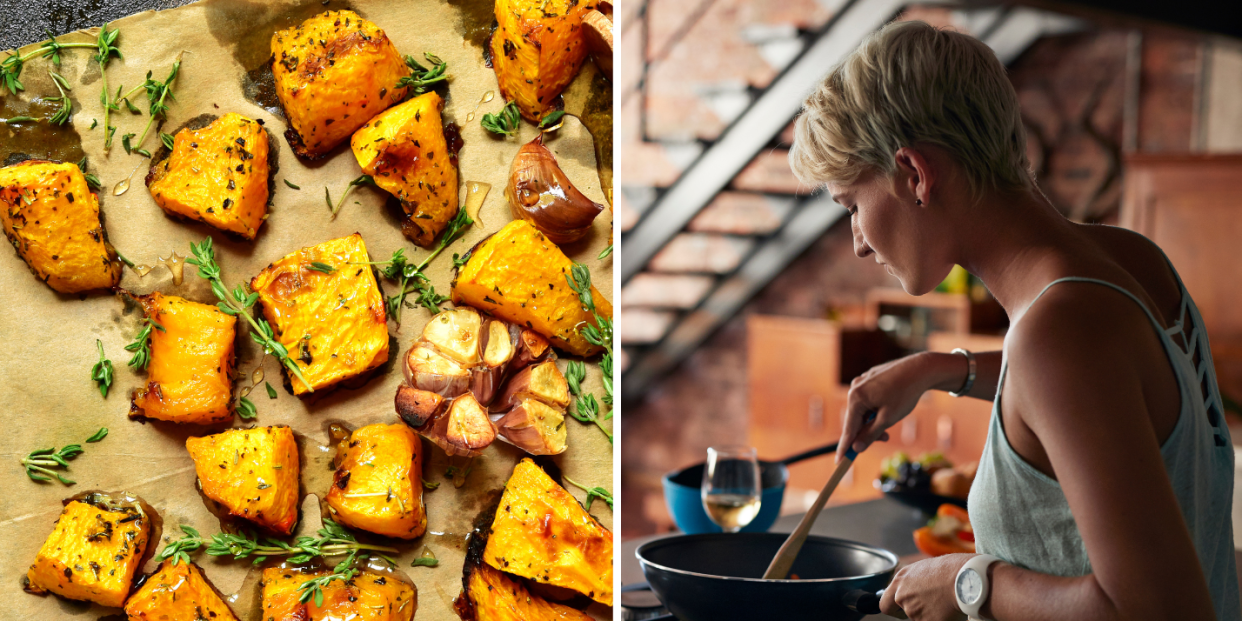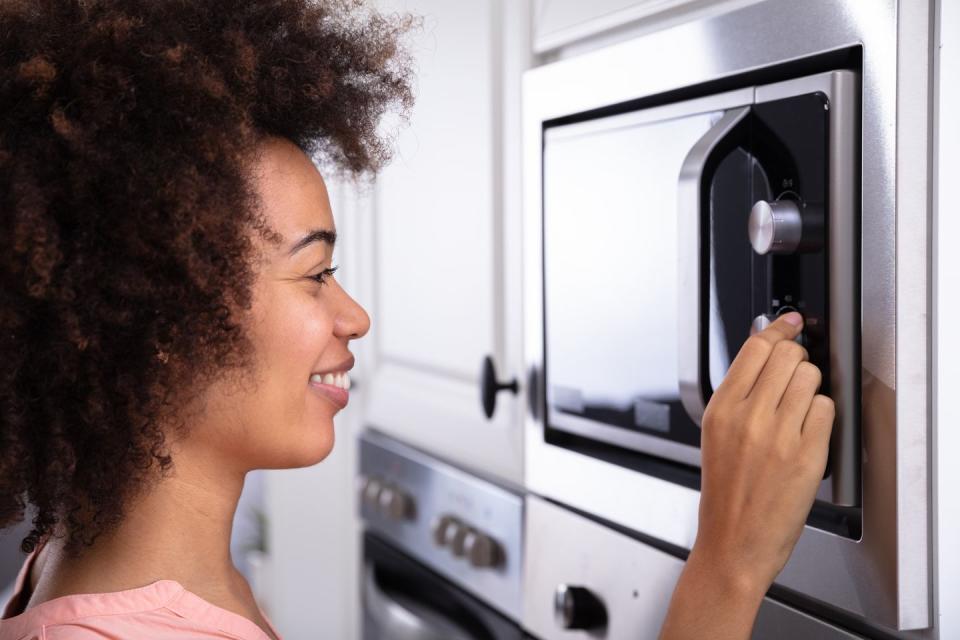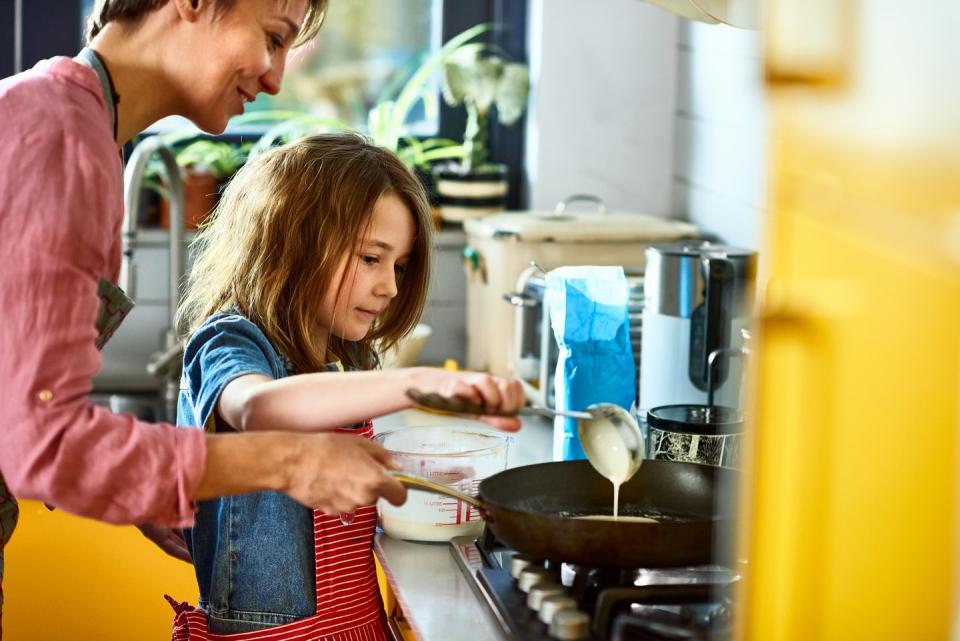20% of your home's energy is used in the kitchen. Here are 18 ways to slash your usage as you cook

No matter how much you've tried to reduce your screen time or news intake, it's impossible to avoid becoming extremely cognisant of how expensive getting energy into your home has become.
With the average energy bill double what it was last winter, most of us are already looking to make changes where we can to reduce the amount of gas and electricity we use at home.
These changes might include turning down the thermostat, putting the heating on less or ensuring lights are switched off around the house. But what about the energy we use when we cook?
The Energy Saving Trust says 20% of a home’s energy consumption occurs in the kitchen. But while slow cookers may be having a resurgence, and air fryers (beloved of celeb foodie and WH fave, Drew Barrymore) are currently flying off the shelves, are they actually cheaper to run than turning on the oven?
And our questions don't just pertain to understanding whether new, much-hyped kitchen gadgets are *actually* worth your (possibly dwindling amount of) cash. We're curious about the basics, too.
Will using the microwave more really save us money? And, when we do need to use the hob? Also, what energy-saving cooking tips will help us keep our energy bills under control?
There’s never been more advice thrown at us about energy-saving in general, and energy-efficient cooking in particular, but what can we do when we cook that will really help to save our pennies? We contacted experts to bust some myths.
How much does it cost to use the oven?
Among the energy-sapping devices in your kitchen, ovens are the biggest culprits; an electric oven can add as much as £335 to your energy bill each year, according to research by energy company Utilita. Meanwhile Hometree, which provides boiler and home emergency cover, puts the energy costs of using the oven at just over £1 an hour. Eesh.
In comparison, Hometree has calculated that slow cookers, which are enjoying a surge in popularity at the moment, use around 5p of energy an hour, while an air fryer will cost around 30p per hour to run.
Using the oven can cost you over £1 an hour
Faced with these figures, it makes sense to use alternative cooking appliances when you can instead of defaulting to the oven. (Though we're not quite going to advise you start using the appliance as shoe storage, Carrie Bradshaw-style.)
So, er, why are ovens so inefficient?
One of the main reasons is because of the size of the internal cavity. Excess energy is used to heat it up as the whole space – not just the tray or dish of food – reaches cooking the temperature you've set the oven to.
However, if you have a fan oven, there is some good news. 'Fan ovens can reduce energy consumption by 20% as they heat and cool the oven faster than conventional electric ovens,' notes Natalie Mathie, an energy expert at Uswitch.
In addition, using your oven more mindfully can help counter the effects of rising energy costs.
How can I save energy when I use the oven?
Here's when it pays - quite literally - to cook according to a schedule. Not only is batch cooking a great time-saver, which seriously reduces your chances of sliding back into the arms of your favourite pizza joint when you can't be bothered to cook at the end of a draining work day, but it's a win where your energy bills are concerned, too.
Here's why. Rather than switching the oven on several times a day, sliding in a tray of tofu chunks to bake as you let your batch of Mediterranean veggies roast means you can avoid pre-heating the oven twice.
Take advantage of the shelves: rather than cooking one lasagne, batch cook a couple then freeze what isn’t used for another day – that can then be defrosted in the fridge and re-heated in the microwave.
Also think how you can make the most of residual heat – energy which would otherwise be wasted but can be useful. Natalie says: 'Residual heat is heat that remains after something like a hob or oven has been heated up. You can use it to warm food, potentially saving energy.'
Think about it: you can warm up bread rolls, toast nuts or heat the dinner plates. In some circumstances, you might also be able to use the residual heat to finish cooking food, or to save energy by not pre-heating the oven.
'If you’re cooking a stew, a braise or a low-temperature meaty slow cook, you can get away without pre-heating the oven – just pop the dish in when you turn the oven on, and you can also turn the oven off 5-10min before the end of the cooking time and use the residual heat to finish the cooking process,' explains Meike Beck, cookery director on Good Housekeeping.

Is the microwave a more energy efficient way to cook?
In a word: yes! The Utilita research puts the average annual cost of using the microwave at just £31.83, while Hometree says your microwave will use less than 2p of electricity every five minutes.
Here's the why. 'Microwaves are cheaper to use because they only heat the food inside them unlike ovens that also heat the air around the food – plus, food takes much less time to cook,' explains Uswitch's Natalie.
While you might use the microwave to re-heat food or for a blast of defrosting, it’s also possible to cook a greater range of dishes in it so now might be a good time to rethink how you use yours.
'Microwaves are best for foods with high moisture contents, as the liquids both help prevent food drying out – an ever present issue with microwave cooking - and also speed up cooking because of the way the microwave works (literally by vibrating water molecules in food),' notes Emma Franklin who, as cookery editor on Good Housekeeping is a font of knowledge on this stuff. Think: soups, stews, risottos, classic one-pot dishes.
To get the best out of your microwave, cover food tightly when cooking and stir often
Emma adds: 'My favourite thing to do in a microwave however is jacket potatoes, as it massively speeds up the cooking time. They’ll still need a short blast in an oven to crisp the skin, but it takes a fluffy baked potato from a 1hr+ cook to a 15min one.'
How can I save energy when I cook on the hob?
Whether you’re using induction, ceramic or gas, Hometree estimates hob cooking costs 17p per quarter of an hour – that means it's likely to cost around three times more to boil or steam veg in a pan than it would be to cook them in the microwave.
However, sometimes the hob is the best option and whatever your set-up, there are tweaks you can make to ensure more efficient cooking.
For example, always put a lid on a pan of boiling water: the pan and liquid will heat up quicker. Remembering to do this simple thing alone can save up to 85% of the energy an uncovered pan would use.
The size of your pan makes a difference, too. Using a pan which is smaller than the hob means there’s heat escaping and being wasted, so match the pan to the size of the hob you are cooking on.
Cook with a lid on your pan and you can save 85% of the energy you'd use without one
If the hob is too big you will lose energy on the sides, while a small hob won’t effectively heat the whole pan. This tip can save around 40% of the energy that would otherwise be wasted by using a pan that's too small.

Passive cooking: what is it and how it can save energy?
So, here's the deal. Passive cooking is an energy-saving cooking technique you can use when you're boiling something on the hob.
It involves turning off the heat under your pan before the end of the cooking time and letting the heat in the water finish the job of cooking the food. It’s not a modern concept – in fact, it was used in the 19th century.
If you’re cooking pasta, add the pasta to a pan of boiling water as normal and leave the heat on for two minutes. Then switch off the heat and leave the pan on the hob, with a lid on for the remaining cooking time. The already-boiled water will finish cooking the pasta. Smart.
Turn the hob off two minutes after your pasta water has boiled - the pasta will cook without it
The Centre for Sustainable Energy estimates the cost of using an electric hob for 10 minutes to be 10p, so by implementing passive cooking you could cook a pan of pasts for just 2p.
'Passive cooking works great for green veggies – add them to boiled water and leave for a few minutes,' says Sophie Nahmad, chef at food box service Gousto.
'The cooking time depends on how much bite you like your veggies to have. Passive cooking works well for poached eggs too – simply crack an egg into just-boiled water and let it cook until soft-set.'
Before you reach for your saucepans, Sophie warns that not everything can be cooked this way: 'I would avoid passive cooking with meat as you won't be able to guarantee that it’s cooked all the way through, and similarly, potatoes or pulses, as they need to be fully cooked to be safe for consumption.'
What other energy-saving cooking tips will save me money?
Elsewhere in the kitchen there are energy savings to be made. You might be in the habit of boiling a full kettle to make a cuppa, but you’ll use less power boiling what you need (providing it's more than the kettle's minimum fill level).
And if the lower end of your kettle's cavity is a no go area given all the flaky limescale that has built up? Then this is your reminder to put 'desclaling kettle' higher up your to-do list. Avoiding the task could be costing you more in energy bills.
Some thrifty consumers swear by filling a thermos with hot water first thing then brewing hot drinks from it all day. A useful hack, too, if you have someone else works from home in your kitchen and doesn't exactly love you coming in and boiling water for your bi-hourly cup of builders while they're on their video calls.
Descale your kettle regularly to make the water at the lower end of the fill level drinkable. You'll be able to boil only what you need for that one hot drink, which will require less energy
Quantity comes into play as you cram your freezer with batch cooked meals: the freezer will not work as efficiently if it’s over-filled so be sure to do a stock take regularly and plan some of the meals you've frozen into your weekly meal plan.
Keep ovens clean and defrost iced up freezers regularly to help appliances to run as they were designed and avoid leaving fridge and freezer doors open longer than necessary. So, that's possibly another couple of jobs to scooch up the list.
And if you're buying a new kitchen appliance...
...bear in mind that energy ratings were overhauled in March last year.
The Energy Saving Trust (EST) advises: 'Energy labels are rated on a scale of A to G, with A being the most efficient. For some product categories, the best available might be a D or an E as we expect these products to become more efficient over time.'
To help keep energy bills down in the long term, think carefully about how big a freezer you really need, for example.
The EST says that a G-rated, 265-litre fridge freezer could cost around £100 a year to run, whereas a larger 424-litre fridge freezer with a better F rating could cost around £105 a year to run based on October 2022 price cap levels.
None of these tips will smooth your way through our economically lean winter, but those small savings stack up and can really help make a difference.
You Might Also Like


